13 Best Herbal Teas For Sinus Headache
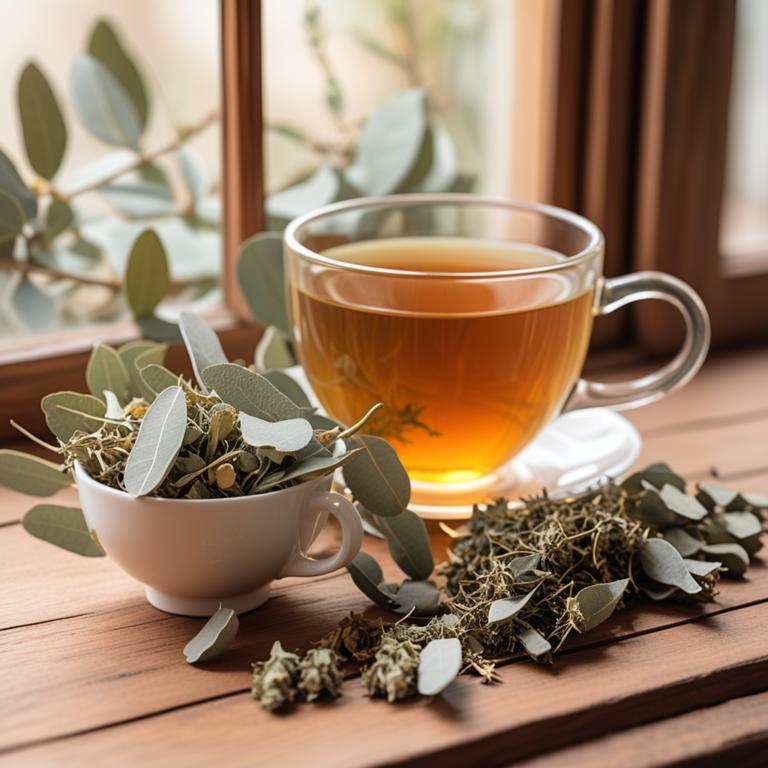
Herbal teas for Sinus headache are a type of natural remedy that utilizes the medicinal properties of various herbs to alleviate the symptoms of sinusitis, a condition characterized by inflammation and congestion of the sinuses.
These teas can treat sinus headaches by reducing inflammation, relieving congestion, and loosening mucus, making it easier to breathe and alleviating the pressure and pain associated with the condition.
Examples of herbal teas that can be used to treat sinus headaches include peppermint tea, which helps to loosen mucus and reduce inflammation, eucalyptus tea, which has natural decongestant properties, ginger tea, which has anti-inflammatory properties that can help to reduce pain and swelling, and thyme tea, which has antimicrobial properties that can help to combat infections.
Additionally, other herbal teas such as chamomile, lavender, and lemon balm tea can also be used to help soothe and calm the sinuses, reducing the severity of symptoms and promoting overall sinus health.
Related Study
According to "Current drug discovery technologies", teas for sinus headache may be effective due to the antinociceptive effects of green tea, which are attributed to its antioxidant and anti-inflammatory properties, particularly the phytochemical component Epigallocatechin -3-gallate (EGCG).
Below there's a list of the 13 best herbal teas for sinus headache.
Table of Contents
- 1. Eucalyptus globulus teas
- 2. Zingiber officinale teas
- 3. Echinacea purpurea teas
- 4. Rosmarinus officinalis teas
- 5. Ginkgo biloba teas
- 6. Lavandula angustifolia teas
- 7. Thymus vulgaris teas
- 8. Sambucus nigra teas
- 9. Cinnamomum verum teas
- 10. Glycyrrhiza glabra teas
- 11. Achillea millefolium teas
- 12. Curcuma longa teas
- 13. Salvia officinalis teas
Also, you may be interested in...
Today Free Bonus!
The Ultimate Herb Drying Checklist
(For Long-Lasting Powerful Medicinal Effect)
How to easily dry herbs that don't mold and that keep their strong medicinal power for more than 1 year.
1. Eucalyptus globulus teas
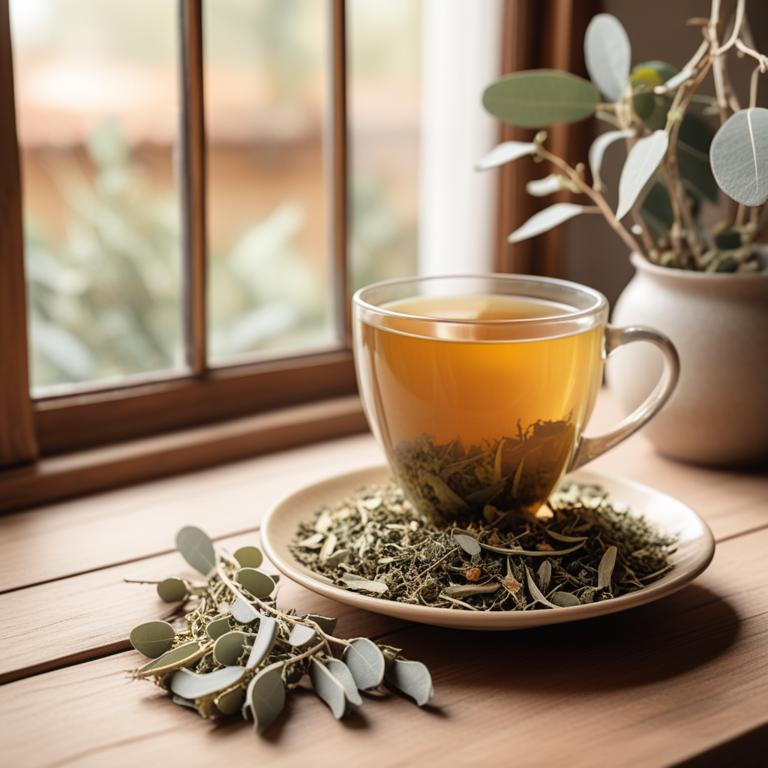
Eucalyptus globulus teas have been traditionally used to treat sinus headaches due to their decongestant, anti-inflammatory, and expectorant properties.
The bioactive constituents, including eucalyptol, limonene, and alpha-pinene, help to relieve sinus pressure and congestion by thinning mucus and reducing inflammation in the nasal passages.
The benefits of this herbal preparation include rapid relief from sinus headaches, improved breathing, and enhanced overall respiratory health.
By using Eucalyptus globulus teas, individuals can naturally alleviate sinus headaches and promote a sense of well-being.
Related Study
According to "Turkish archives of otorhinolaryptology", Eucalyptus globulus teas, which are a component of the herbal preparation Sinulan forte®, may be a safe and effective treatment for acute postviral rhinosinusitis (APRS), showing significant improvement in symptoms such as nasal congestion, facial pain, and loss of sense of smell.
Recipe:
- Gather 1 cup of water, 1 tablespoon of dried Eucalyptus globulus leaves, and a tea infuser or a small strainer.
- Heat the water in a pot until it boils.
- Add the dried Eucalyptus globulus leaves to the tea infuser or strainer.
- Steep the leaves in the hot water for 5-7 minutes, then remove the leaves.
- Strain the tea into a cup and drink immediately to help relieve sinus headache.
Eucalyptus globulus teas can provide relief from sinus headaches, but consuming it excessively or for an extended period may lead to side effects such as stomach upset, nausea, and dizziness due to its essential oils and menthol content.
To safely use Eucalyptus globulus teas for sinus headaches, it is recommended to start with small amounts, avoid mixing it with other medications, and be cautious when consuming it before surgery or when driving, as it can cause drowsiness or affect judgment.
Eucalyptus Globulus Tea on Amazon
Jovvily Eucalyptus Leaves - 1lb - Dried - Cut & Sifted - Herbal Tea
Disclaimer: We earn a commission if you click this link and make a purchase at no additional cost to you.
2. Zingiber officinale teas

Zingiber officinale teas, also known as ginger tea, have been traditionally used to treat sinus headache ailments due to their anti-inflammatory and expectorant properties.
The bioactive constituents, including gingerols and shogaols, help to reduce inflammation, ease congestion, and provide relief from headache symptoms.
The warm and soothing properties of ginger tea help to calm the sinuses, reduce pressure, and promote drainage, thereby providing quick relief from sinus headaches.
Regular consumption of Zingiber officinale teas has been found to be beneficial in reducing the frequency and severity of sinus headaches, making it a popular natural remedy for this common ailment.
Related Study
According to the study, Zingiber officinale teas for sinus headache may be beneficial as it has been shown to exhibit gastroprotective and anti-inflammatory effects, which may help manage gastrointestinal abnormalities associated with headaches.
Recipe:
- Gather 1 tablespoon of fresh Zingiber officinale (ginger) root.
- Peel the ginger root and chop it into small pieces.
- Boil 1 cup of water in a pot.
- Add the chopped ginger pieces to the boiling water and reduce heat.
- Steep the ginger in the water for 5-7 minutes, then strain and drink.
Zingiber officinale teas can help alleviate sinus headache symptoms, but possible side effects may include stomach upset, nausea, and diarrhea due to its spicy and warming nature.
To minimize potential side effects, it is recommended to start with small amounts, avoid consuming it on an empty stomach, and choose a low-potency or ginger tea that is specifically designed for sinus relief.
Zingiber Officinale Tea on Amazon
FGO Organic Ginger Tea, 100 Count, Eco-Conscious Tea Bags, Caffeine Free, Packaging May Vary (Pack of 1)
Disclaimer: We earn a commission if you click this link and make a purchase at no additional cost to you.
3. Echinacea purpurea teas

Echinacea purpurea teas have been traditionally used to treat sinus headache ailments due to their anti-inflammatory and immunomodulatory properties.
The herbal preparation helps to treat this condition by reducing swelling and congestion in the nasal passages, thereby alleviating the associated headache.
The bioactive constituents of Echinacea purpurea, including alkylamides, caffeic acid derivatives, and flavonoids, contribute to its therapeutic effects by exhibiting antihistamine, antiviral, and antioxidant activities.
Regular consumption of Echinacea purpurea teas has been found to provide relief from sinus headaches and promote overall respiratory health, making it a popular natural remedy for this common affliction.
Related Study
According to this review in "Recent patents on biotechnology", Echinacea purpurea teas may have potential for adjuvant symptomatic therapy in respiratory conditions, including sinus headache, due to its bioactive compounds.
Recipe:
- Gather 1 cup of fresh or dried Echinacea purpurea flowers.
- Measure 1 tablespoon of the Echinacea flowers and place in a heat-resistant cup.
- Boil 1 cup of water in a kettle or on the stove.
- Pour the boiling water over the Echinacea flowers in the cup.
- Let the mixture steep for 5-7 minutes, then strain and drink.
Echinacea purpurea teas can be an effective treatment for sinus headaches, but it may cause side effects such as digestive issues, allergic reactions, and interactions with other medications, particularly blood thinners and diabetes medications.
To use Echinacea purpurea teas safely, take it in moderation, avoid consuming it if you have a known allergy, and be cautious when taking it with other herbal or pharmaceutical preparations.
Echinacea Purpurea Tea on Amazon
BLUE TEA - Chamomile Tea - Butterfly Pea Flower -18 Count - Pyramid Tea Bag | DETOX TEA | Caffeine Free - Flower Based - Vegan - Non-Bitter - Natural Ingredients | Tin Packaging
Disclaimer: We earn a commission if you click this link and make a purchase at no additional cost to you.
4. Rosmarinus officinalis teas

Rosmarinus officinalis teas have been used as a natural remedy to treat sinus headaches, leveraging its anti-inflammatory and antimicrobial properties to help alleviate symptoms.
This herbal preparation helps to treat sinus headaches by reducing nasal congestion and inflammation, promoting a clear nasal passage and relieving pressure.
The bioactive constituents of Rosmarinus officinalis teas, including carnosic acid, rosmarinic acid, and camphor, have been identified as key players in its therapeutic effects, contributing to their antimicrobial and anti-inflammatory properties.
The benefits of using Rosmarinus officinalis teas to treat sinus headaches include reduced symptoms, improved breathing, and enhanced overall well-being, making it a popular natural remedy among those seeking alternative treatments.
Recipe:
- Gather 1 cup of boiling water and 1 tablespoon of dried Rosmarinus officinalis leaves.
- Measure 1 cup of boiling water into a teapot or cup. Add 1 tablespoon of dried Rosmarinus officinalis leaves.
- Let the Rosmarinus officinalis leaves steep in the boiling water for 5-7 minutes.
- Strain the tea into another cup using a tea strainer or cheesecloth to remove the leaves.
- Drink the tea slowly and enjoy. You can add honey or lemon to taste.
Rosmarinus officinalis teas can be effective in treating sinus headaches, but they may also cause side effects such as dizziness, nausea, and stomach upset in some individuals.
To use Rosmarinus officinalis teas safely, it is recommended to start with a small dose, avoid consuming them before bedtime, and be cautious when driving or operating heavy machinery due to their potential sedative effects.
Rosmarinus Officinalis Tea on Amazon
Palm Beach Medicinal Herbs - Rosemary Tea - Pure Herbal Tea Series, 30ct
Disclaimer: We earn a commission if you click this link and make a purchase at no additional cost to you.
5. Ginkgo biloba teas

Ginkgo biloba teas have been traditionally used to treat sinus headaches due to their anti-inflammatory and vasodilatory properties.
The flavonoids and terpenoids present in Ginkgo biloba teas help to improve blood circulation and reduce inflammation in the nasal passages, alleviating sinus headache symptoms.
The bioactive constituents, including bilobalide and ginkgolides, have been shown to inhibit the release of pro-inflammatory mediators and improve the functioning of the nasal mucosa.
Regular consumption of Ginkgo biloba teas may help to reduce the frequency and severity of sinus headaches, providing relief from associated symptoms such as congestion and facial pain.
Related Study
According to "American journal of health-system pharmacy : AJHP : official journal of the American Society of Health-System Pharmacists", Ginkgo biloba teas may potentially be safe for use in alleviating sinus headaches, as it is listed among the potentially safe herbs.
Recipe:
- Gather 1 teaspoon of dried Ginkgo biloba leaves and 1 cup of boiling water.
- Add the Ginkgo biloba leaves to a tea infuser or a heat-resistant cup.
- Pour the boiling water over the Ginkgo biloba leaves and let it steep for 5-7 minutes.
- Strain the tea into a cup and discard the Ginkgo biloba leaves.
- Drink the tea 2-3 times a day to help relieve sinus headache symptoms.
Ginkgo biloba teas can help alleviate sinus headaches due to their anti-inflammatory properties and ability to improve blood circulation, but possible side effects include dizziness, stomach upset, and increased risk of bleeding.
To use Ginkgo biloba teas safely, take precautions such as monitoring blood pressure and avoiding consumption before surgery, as well as being cautious when combining with other medications that may also thin the blood.
Ginkgo Biloba Tea on Amazon
Tai Chi Think Sharp Energizing Tea (Ginseng Ginkgo Biloba) 12 Bags
Disclaimer: We earn a commission if you click this link and make a purchase at no additional cost to you.
6. Lavandula angustifolia teas

Lavandula angustifolia teas, also known as English lavender tea, have been used to treat sinus headaches due to their calming and decongestant properties.
The herbal preparation helps to treat this ailment by promoting relaxation, reducing inflammation, and alleviating congestion.
Bioactive constituents such as linalool and linalyl acetate, which are responsible for the tea's calming effects, play a significant role in reducing sinus pressure and promoting sinus drainage.
Regular consumption of Lavandula angustifolia teas has been shown to provide relief from sinus headaches, promoting a restful night's sleep and reducing the frequency and severity of headaches.
Recipe:
- Gather 1 cup of water and 1 tablespoon of dried Lavandula angustifolia flowers.
- Heat the water in a pot until it boils.
- Add the dried flowers to the boiling water and remove from heat.
- Let the mixture steep for 5-7 minutes, then strain the liquid.
- Drink the tea warm, 2-3 times a day, to help relieve sinus headache symptoms.
Lavandula angustifolia teas can be used to alleviate sinus headache symptoms, but potential side effects include drowsiness, stomach upset, and allergic reactions, particularly in individuals with sensitive skin or respiratory issues.
Precautions when using Lavandula angustifolia teas for sinus headaches include avoiding driving or operating heavy machinery due to potential drowsiness, and starting with small amounts to assess individual tolerance and sensitivity.
Lavandula Angustifolia Tea on Amazon
Tiesta Tea - Lavender Chamomile Herbal Tea | Loose Leaf | Calming Blend with Chamomile and Lavender | Caffeine-Free Herbal | Great for Hot or Iced Brews | Resealable Bulk Pouch, 200 Cups | 8 Ounce
Disclaimer: We earn a commission if you click this link and make a purchase at no additional cost to you.
7. Thymus vulgaris teas
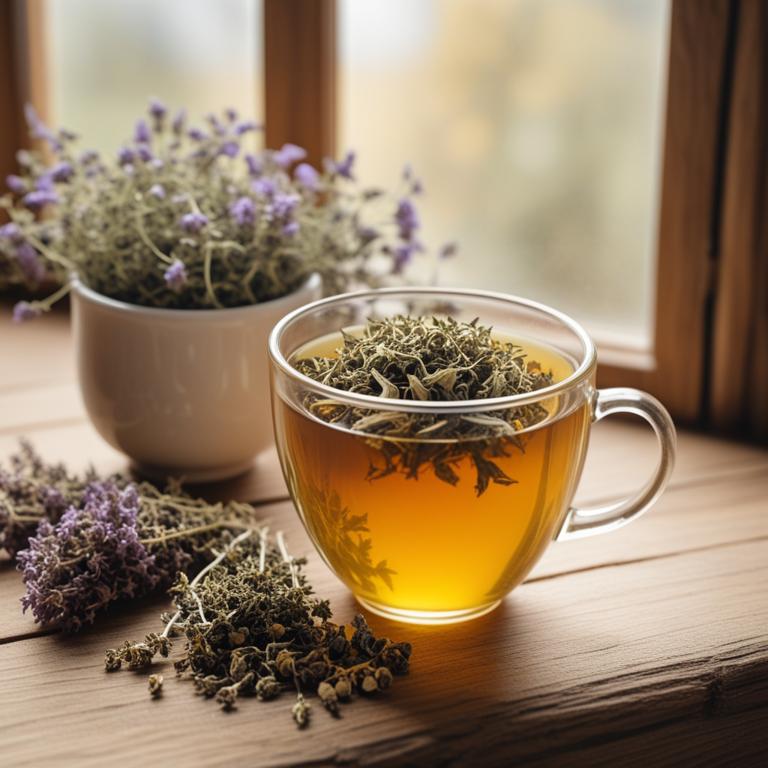
Thymus vulgaris teas, also known as thyme tea, have been used for centuries to treat sinus headaches due to their anti-inflammatory and antimicrobial properties.
The herbal preparation helps to treat this ailment by reducing congestion and relieving sinus pressure, making it easier to breathe and alleviate headache symptoms.
Thymus vulgaris teas contain bioactive constituents such as thymol, carvacrol, and rosmarinic acid, which contribute to their therapeutic effects by inhibiting the growth of bacteria and viruses that can cause sinus infections.
The benefits of this herbal preparation include natural pain relief, reduced inflammation, and improved respiratory function, making it a popular natural remedy for sinus headache sufferers.
Related Study
According to "Ceska a Slovenska farmacie : casopis Ceske farmaceuticke spolecnosti a Slovenske farmaceuticke spolecnosti", Thymus vulgaris teas can be used in combination with other medicinal plants to constitute efficient help in the treatment of upper respiratory tract diseases, including sinus headache, by reducing the need of antibiotic therapy and shortening the duration of the disease.
Recipe:
- Gather 1 tablespoon of dried thyme leaves (Thymus vulgaris) and a cup of boiling water.
- Pour the boiling water over the thyme leaves in a cup and let it steep for 5-7 minutes.
- Strain the tea into another cup to remove the thyme leaves.
- Add honey to taste, if desired, to make the tea sweeter.
- Drink the tea hot or warm, 2-3 times a day, to help relieve sinus headache symptoms.
Thymus vulgaris teas can be used to treat sinus headaches due to its decongestant and antimicrobial properties, but possible side effects may include allergic reactions, nausea, and stomach upset, especially when consumed in large quantities.
To minimize risks, it's essential to use high-quality Thymus vulgaris teas, start with small amounts, and avoid mixing it with other medications or herbal supplements, as this may exacerbate the side effects and interact with other health conditions.
Thymus Vulgaris Tea on Amazon
Buddha Teas Organic Thyme Leaf Tea - OU Kosher, USDA Organic, CCOF Organic, 18 Bleach-Free Tea Bags
Disclaimer: We earn a commission if you click this link and make a purchase at no additional cost to you.
8. Sambucus nigra teas

Sambucus nigra teas, derived from the elderberry plant, have been traditionally used to treat sinus headaches due to their anti-inflammatory and antihistamine properties.
The bioactive constituents, including flavonoids and anthocyanins, help to alleviate sinus pressure and congestion by reducing inflammation and promoting drainage.
By soothing the nasal passages and sinuses, Sambucus nigra teas provide relief from sinus headache symptoms, such as facial pain and pressure, allowing for improved breathing and a reduction in discomfort.
The benefits of using Sambucus nigra teas to treat sinus headaches include natural and non-habit forming relief, as well as reduced reliance on over-the-counter medications.
Recipe:
- Gather 1 cup of fresh or dried Sambucus nigra flowers.
- Combine 1 cup of flowers with 1 cup of boiling water in a saucepan.
- Steep for 5-7 minutes, then strain the mixture.
- Mix 1 tablespoon of honey with the tea to taste, if needed.
- Drink 1 cup of the tea, 2-3 times a day, as needed for sinus headache relief.
Sambucus nigra teas can be used to treat sinus headaches due to their decongestant and anti-inflammatory properties, but possible side effects may include stomach upset, nausea, and allergic reactions such as hives or itching.
Precautions should be taken when using Sambucus nigra teas, as they may interact with medications or exacerbate conditions such as high blood pressure, and should be consumed in moderation, especially for pregnant or breastfeeding women.
Sambucus Nigra Tea on Amazon
Elderberry Turmeric Ginger Tea - Made in USA
Disclaimer: We earn a commission if you click this link and make a purchase at no additional cost to you.
9. Cinnamomum verum teas

Cinnamomum verum teas have been traditionally used to treat sinus headaches due to their anti-inflammatory and antiseptic properties, which help to reduce swelling and alleviate pain.
The bioactive constituents of Cinnamomum verum, including cinnamaldehyde and eugenol, have been found to exhibit analgesic and antipyretic activities, making it an effective remedy for sinus headaches.
Drinking Cinnamomum verum teas helps to loosen and clear mucus, providing relief from congestion and sinus pressure.
The benefits of using Cinnamomum verum teas to treat sinus headaches include rapid relief, improved respiratory function, and reduced risk of infection.
Recipe:
- Gather 1 cup of fresh Cinnamomum verum leaves or 2 teaspoons of dried leaves.
- Boil 1 cup of water in a kettle or pot.
- Add the Cinnamomum verum leaves to the boiling water.
- Reduce heat and let it simmer for 5-7 minutes. Strain the tea into a cup.
- Add 1 tablespoon of honey to the tea, if desired, and drink while warm.
Cinnamomum verum teas can be used to treat sinus headache, but it may cause side effects such as stomach upset, nausea, and allergic reactions in some individuals, particularly when consumed in large quantities or for extended periods.
Precautions should be taken when using Cinnamomum verum teas to treat sinus headache, including avoiding consumption by pregnant or breastfeeding women, and individuals with pre-existing conditions such as diabetes or high blood pressure.
Cinnamomum Verum Tea on Amazon
Lavendium, 20 Pure Cinnamon Tea Bags, Made of 100% Natural Cinnamon Sticks, Cinnamon Herbal Tea, No Additives, No Caffeine, No Gluten, Vegan.
Disclaimer: We earn a commission if you click this link and make a purchase at no additional cost to you.
10. Glycyrrhiza glabra teas

Glycyrrhiza glabra teas, also known as licorice root tea, have been traditionally used to treat sinus headaches due to their anti-inflammatory and antispasmodic properties, which help to reduce swelling and ease pain in the nasal passages and sinuses.
The bioactive constituents of licorice root, including glycyrrhizin and flavonoids, contribute to its therapeutic effects by inhibiting the production of pro-inflammatory enzymes and promoting relaxation of the smooth muscle in the sinus tissues.
By reducing inflammation and promoting relaxation, Glycyrrhiza glabra teas can help to alleviate sinus headache symptoms, such as nasal congestion, facial pain, and pressure.
The benefits of using licorice root tea to treat sinus headaches include its natural and non-addictive properties, making it a safe and effective alternative to over-the-counter medications.
Related Study
According to Turkish archives of otorhinolaryngology, Glycyrrhiza glabra teas may be a safe and effective treatment option for acute postviral rhinosinusitis (APRS), which includes symptoms commonly associated with sinus headache, as the herbal preparation Sinulan forte, which contains extracts of Glycyrrhiza glabra among other plants, showed significant improvements in symptoms such as facial pain and sense of smell, and had no adverse effects in patients with APRS.
Recipe:
- Gather 1 cup of fresh or dried Glycyrrhiza glabra roots.
- Chop the roots into small pieces.
- Boil 2 cups of water in a pot.
- Add 1 tablespoon of the chopped roots to the boiling water and let it simmer for 5-7 minutes.
- Strain the liquid and drink 1 cup of the tea 2-3 times a day to help relieve sinus headache.
Glycyrrhiza glabra teas can be used to treat sinus headache, but potential side effects include excessive potassium loss, leading to muscle weakness, fatigue, and heart palpitations.
When using these teas, it is essential to consume them in moderation and stay hydrated, as prolonged use can also cause headaches, insomnia, and an increase in blood pressure.
Glycyrrhiza Glabra Tea on Amazon
Pukka Herbal Teas Licorice and Cinnamon - 20 Bags, 20 Count
Disclaimer: We earn a commission if you click this link and make a purchase at no additional cost to you.
11. Achillea millefolium teas
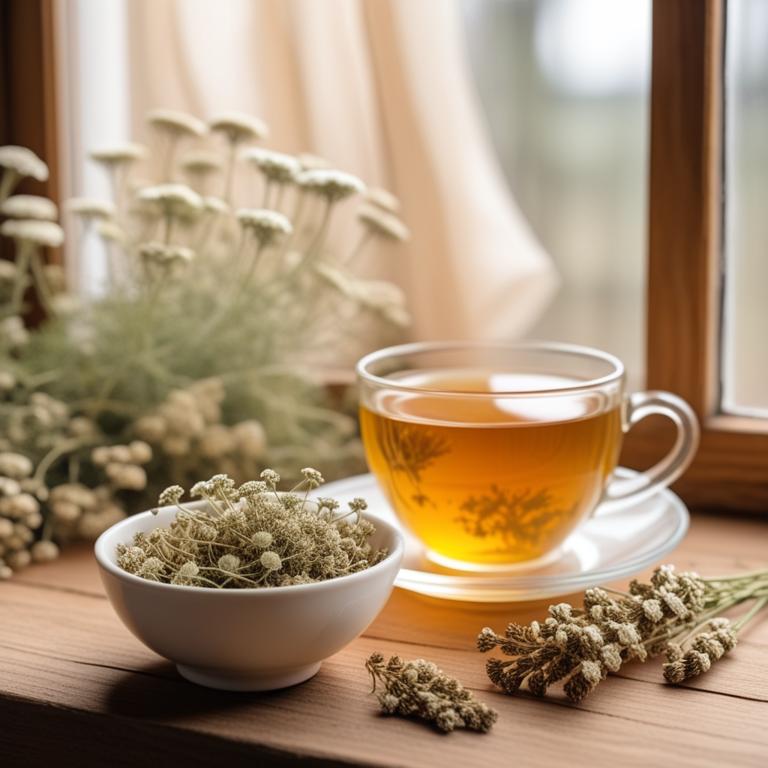
Achillea millefolium teas, also known as yarrow tea, have been traditionally used to treat sinus headaches due to their anti-inflammatory, antispasmodic, and expectorant properties.
These properties help to alleviate sinus pressure and congestion, thereby reducing the frequency and severity of sinus headaches.
The bioactive constituents of Achillea millefolium, including sesquiterpene lactones, flavonoids, and phenolic acids, contribute to its analgesic and anti-inflammatory effects, which help to soothe and calm the sinus passages.
Drinking Achillea millefolium tea regularly can help to provide relief from sinus headaches by reducing inflammation, promoting drainage, and calming the nervous system, making it a natural and effective remedy for this common ailment.
Recipe:
- Gather 2 tablespoons of dried Achillea millefolium leaves.
- Pour 1 cup of boiling water over the leaves in a cup.
- Steep for 5-7 minutes to allow the leaves to release their flavor and properties.
- Strain the tea and discard the leaves.
- Drink the tea hot or let it cool to room temperature, as needed.
Achillea millefolium teas can be used to treat sinus headache, but it may cause side effects such as dizziness, nausea, and allergic reactions in some individuals, particularly those with known allergies or sensitivities.
Precautions to take when using Achillea millefolium teas include starting with small amounts, avoiding it if you have bleeding disorders or are prone to heavy menstruation, and being cautious when combining it with other medications or herbal supplements.
Achillea Millefolium Tea on Amazon
Biokoma Pure and Organic Yarrow Dried Herb 30 Tea Bags 1.5oz In Resealable Moisture Proof Pouch, USDA Certified Organic - Herbal Tea, No Additives, No Preservatives, No GMO, Kosher
Disclaimer: We earn a commission if you click this link and make a purchase at no additional cost to you.
12. Curcuma longa teas
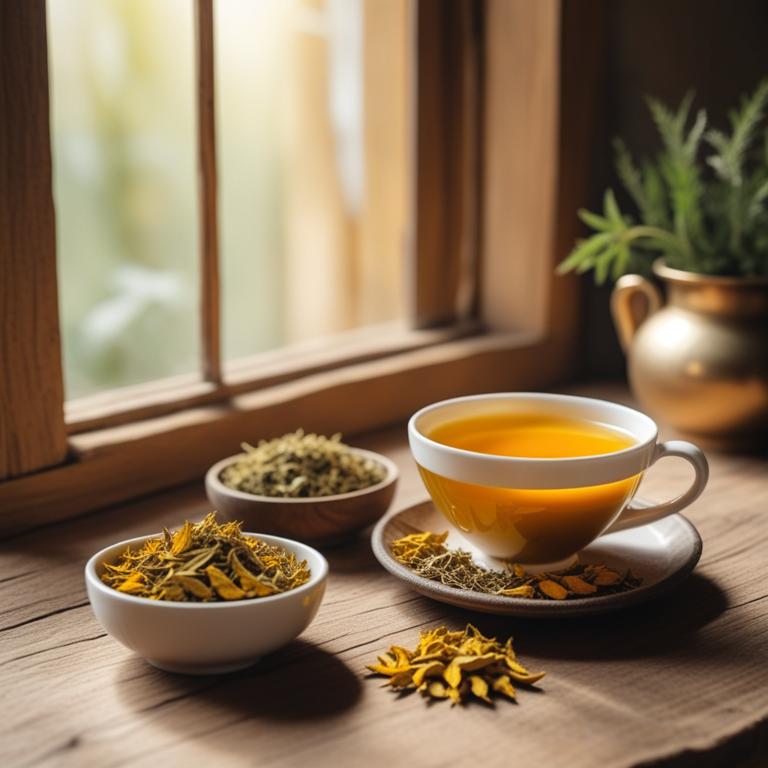
Curcuma longa teas, derived from the rhizomes of the turmeric plant, have been traditionally used to treat sinus headaches due to their anti-inflammatory and antioxidant properties.
The bioactive constituents, including curcumin, demethoxycurcumin, and bisdemethoxycurcumin, exhibit potent anti-inflammatory and pain-relieving effects, helping to alleviate sinus pressure and congestion.
By inhibiting the production of pro-inflammatory enzymes and cytokines, Curcuma longa teas help to reduce swelling and soothe the nasal passages, providing relief from sinus headaches.
The benefits of using Curcuma longa teas to treat sinus headaches include reduced inflammation, improved respiratory function, and a decrease in the severity and frequency of headaches.
Related Study
According to "International journal for vitamin and nutrition research. Internationale Zeitschrift fur Vitamin- und Ernahrungsforschung. Journal international de vitaminologie et de nutrition", Curcuma longa teas may be beneficial for sinus headache as the extract of Curcuma longa was shown to decrease tracheal responsiveness to methacholine, which can be associated with relief from sinus-related issues.
Recipe:
- Boil 1 cup of water in a pot.
- Add 1/2 teaspoon of dried Curcuma longa root to the boiling water.
- Reduce heat and let it simmer for 5-7 minutes.
- Strain the tea into a cup and add honey to taste, if desired.
- Drink the tea while warm, 2-3 times a day, as needed for sinus headache relief.
Curcuma longa teas can be used to treat sinus headaches due to its anti-inflammatory properties, but it may cause side effects such as stomach upset, diarrhea, and nausea in some individuals.
To use Curcuma longa teas safely, it is essential to start with a low dose and gradually increase as needed, and to be cautious of allergic reactions, such as skin irritation or rash, and to avoid consuming it on an empty stomach to minimize stomach upset.
Curcuma Longa Tea on Amazon
Pure Ceylon Turmeric Brew - 100% Organic Ceylon Turmeric Tea Bags (40 Sachets - pack of 2 – 20 COUNT PER BOX)
Disclaimer: We earn a commission if you click this link and make a purchase at no additional cost to you.
13. Salvia officinalis teas
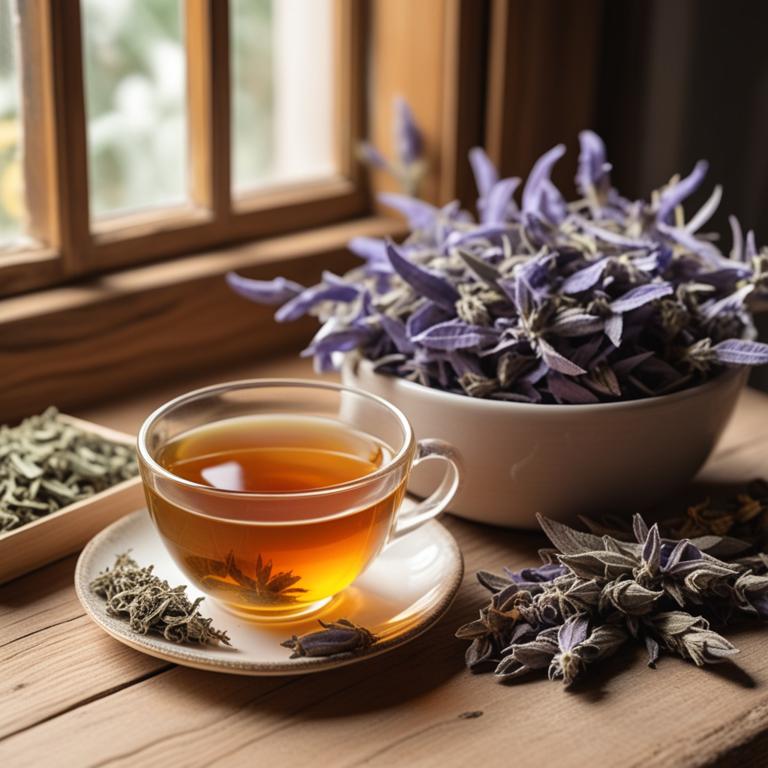
Salvia officinalis teas have been traditionally used to treat sinus headaches due to their decongestant and anti-inflammatory properties.
The herbal preparation helps to treat this ailment by relieving nasal congestion and reducing pain and swelling in the sinuses.
The bioactive constituents of Salvia officinalis, including rosmarinic acid and carnosic acid, exhibit antioxidant and anti-inflammatory activities that contribute to its therapeutic effects.
Drinking Salvia officinalis teas can provide relief from sinus headaches by soothing the nasal passages and sinuses, promoting relaxation, and improving overall respiratory health.
Recipe:
- Gather 1 cup of fresh or dried Salvia officinalis leaves.
- Measure 1 tablespoon of the leaves and place them in a heat-resistant cup.
- Boil 8 ounces of water in a kettle or on the stove.
- Pour the boiling water over the Salvia leaves in the cup and let it steep for 5-7 minutes.
- Strain the tea and discard the leaves. Drink the tea while it is still warm.
Salvia officinalis teas can be used to treat sinus headaches due to their anti-inflammatory and decongestant properties, but possible side effects may include dry mouth, dizziness, and stomach upset.
To safely use Salvia officinalis teas for this purpose, take small amounts, avoid combining with other medications, and be cautious when consuming if you have pre-existing conditions such as high blood pressure or kidney disease.
Salvia Officinalis Tea on Amazon
Organic India Tulsi Sweet Rose Herbal Tea - Holy Basil Leaf, African Basil, Chamomilie, Lemon Myrtle, Stress Relieving, Immune Support, USDA Certified Organic, Caffeine-Free - 18 Infusion Bags, 6 Pack
Disclaimer: We earn a commission if you click this link and make a purchase at no additional cost to you.